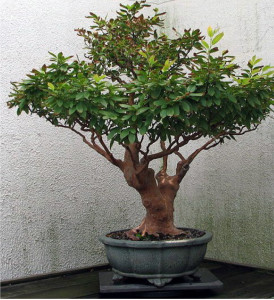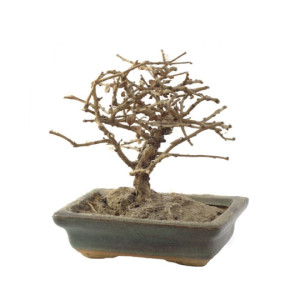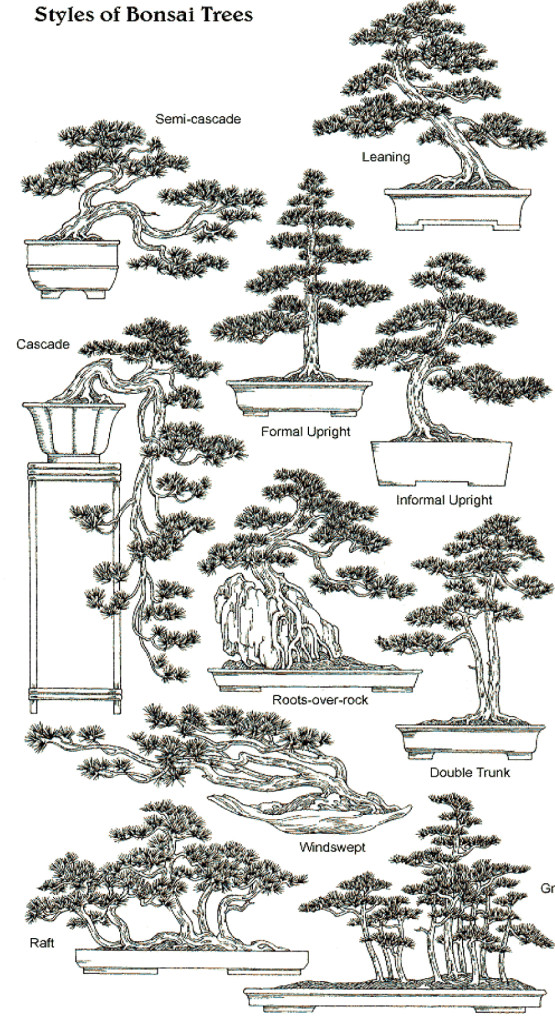by Barry Johnson ©
Being a 6’ 3” bruiser it’s hard to think I could possibly get enthused about bonsaied anything. Mind you, in my football days, playing as a ruckman, I did appreciate the services of a couple of little rover over the years.
During my horticultural journey I have dabbled from time to time in the art of bonsai. However, I have to admit that I have kamikazes all these plants owing to the lack of time, dedication and commitment to do justice to this refined form of horticulture. I now appreciate the efforts of others and go to my local Japanese restaurant and eat sushi and sashimi.
In spite of my failings, if you have the time and constancy to give to the subject it can be a very stimulating and rewarding pastime. Time means, bonsai does not take kindly to neglect and if you are of that ilk, grow cacti. By constancy, I mean, you have to be somebody who is always around. Going on holidays and leaving your bonsai collection to the elements or, heaven forbid your relatives to look after is not an option. They may not be big and they may not need a lot of water but, without this basic requirement, mostly daily, they will commit hari kari. Far be it from me to deter anyone, if you fit the homebody criteria then bonsai is for you. Locating your bonsai specimens to receive some natural rain would also be beneficial.
Going to any bonsai specialist nursery or show and drooling over the sheer artistic beauty and value of enthusiasts specimens is enough to whet anyone’s appetite to have a go.
While you can always source starter plants for your collection, the first error the uninitiated make is presuming that bonsai-ed plants are indoor plants. At best they are occasional indoor plants that can be brought inside to adorn your interior to impress visiting friends. By occasional means, for a couple of days or so.
Bonsais are ostensibly garden plants cultivated to induce dwarfism so; they need plenty of fresh air and light. Your outdoor bonsai collection needs to be ideally sited away from the ravages of summer sun and hot, drying winds. The optimum situation would some morning sun or under protective dappled shade either natural of artificial (shade cloth).
Many camellias are perfectly suited to bonsai. The major reasons why they are suitable are their slow growth rates and refined root systems. Like all bonsai candidates they have be suitable species and cultivars in the first place.
Nobody in their right mind is going to try and bonsai a Mountain Ash tree and it is the same with our camellias to a lesser degree. Picking camellia varieties that have refined growth habits and leaves is a good place to start.
Some suggested varieties are h.Bonsai Baby, h.Sweet Emily Kate, s.Shishi Gashira, h.Baby Bear, sp.Tricholclada, sp.Grissji, s.Little Liane, h.TransTasman, s.Yuletide, s.Marge Miller, s.Snow, s.Slim n Trim, j.Unryu, s. Mignonne, s.Paradise Petite, sp.Cuspidata, h.Gay Baby, Sp. Maliflora, h. Minato-no-Akebono and many other sasanquas.
Bonsai-ed plants can be adapted to grow in many styles. (see illustration at the end of this article) My earliest bonsai-ng experiences actually involved the days of terrariums whereby indoor plants were grown in fish tanks, jars or bowls etc. and plants were cultivated and trimmed to suit. However, the bonsai of the Japanese ancients, using traditionally outdoor grown cultivars, has evolved into a more structural form. Styles such as formal and informal upright, leaning, grouping, cascade and semi-cascade and multi-trunk can all be adapted to camellia bonsai.
Apart from the bleeding obvious – water; other vital ingredients are; specialist bonsai potting mix; suitable containers, maintenance tools and accessories such as training wire and display stand. In addition, a good reference book or, Googling the internet will provide a wealth of information on the subject.
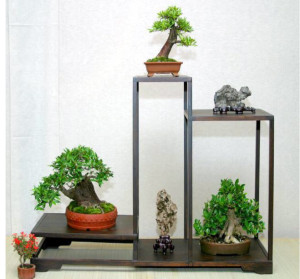 In relation to bonsai containers and display stands, the whole ‘oriental’ concept of bonsai can be destroyed by using unaesthetic pots and display stands.
In relation to bonsai containers and display stands, the whole ‘oriental’ concept of bonsai can be destroyed by using unaesthetic pots and display stands.
After planting up your bonsai specimen you will have to repot it about every two years. The repotting process will probably involve top and root pruning. The top pruning will create and preserve the desired shape of the plant. In time, you will also have upsize your ornamental pot. Repotting is usually carried out during later winter or early spring. Heavy pruning should be carried out in autumn, winter or early spring. Other general pruning can be carried out during the normal growing season. Root stimulating plant tonic can be applied after repotting.
 Wiring the trunk and branches while they are young and pliable is the technique used to train them into the desired shape and style. While wiring, gentle bending methods should be employed with extra care taken not to damage emerging flower or growth buds and existing foliage. The training wires should be checked regularly and not left on too long as to damage the plants bark. Remember, any damage you inflict on your bonsai may debilitate its growth, detract from its appearance and lessen its monetary value.
Wiring the trunk and branches while they are young and pliable is the technique used to train them into the desired shape and style. While wiring, gentle bending methods should be employed with extra care taken not to damage emerging flower or growth buds and existing foliage. The training wires should be checked regularly and not left on too long as to damage the plants bark. Remember, any damage you inflict on your bonsai may debilitate its growth, detract from its appearance and lessen its monetary value.
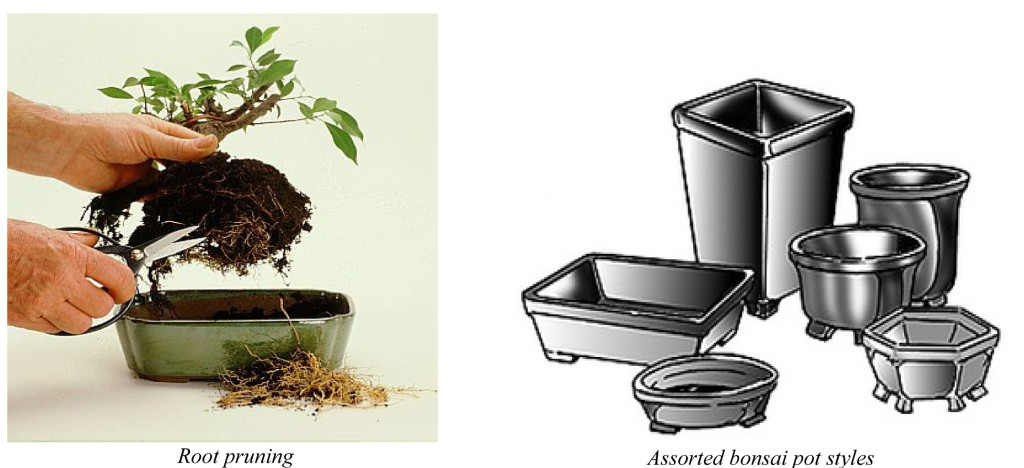 Bonsai are no different to any other plant whereby, they need fertilizing. For camellias, using a weak (1/2 strength) solution of a quality liquid fertilizer such as Thrive and/or Phostrogen (potash enriched) and occasional applications of tonics such as Seasol, every two weeks during spring and summer, is advisable. Do not apply fertilizers in hot weather e.g. over 25?c. Watch for signs of fertilizer burn on leaf margins and if evident, reduce strength marginally.
Bonsai are no different to any other plant whereby, they need fertilizing. For camellias, using a weak (1/2 strength) solution of a quality liquid fertilizer such as Thrive and/or Phostrogen (potash enriched) and occasional applications of tonics such as Seasol, every two weeks during spring and summer, is advisable. Do not apply fertilizers in hot weather e.g. over 25?c. Watch for signs of fertilizer burn on leaf margins and if evident, reduce strength marginally.
As bonsai plants are refined forms of garden plants, practitioners should be vigilant against attack by pests and diseases etc. as they would take no time debilitate or destroy your handiwork.
Any ornamental enhancement of your bonsai specimens should be minimal, in harmony and true to oriental, bonsai concepts. Containers can contain ornamental rocks, figurines and can look good if surfaced with fine granular toppings such as granite or quartz and/or moss.
Another factor to consider if you really embrace the art of bonsai is security. This is especially so when your charges become valuable, aged specimens.
Root pruning Assorted bonsai pot styles
Many specialist bonsai nurseries have experienced large-scale burglaries for their collections. By all means show them off to your trusted friends but don’t show them on You Tube.

